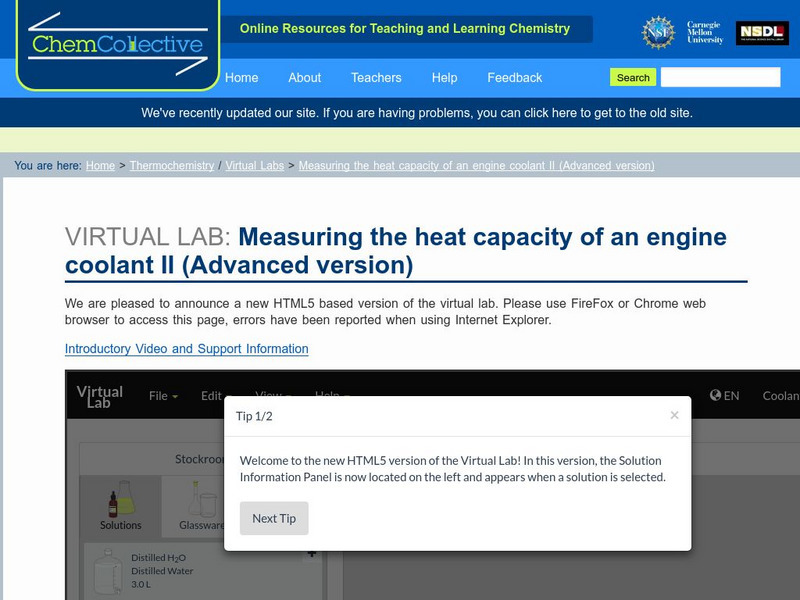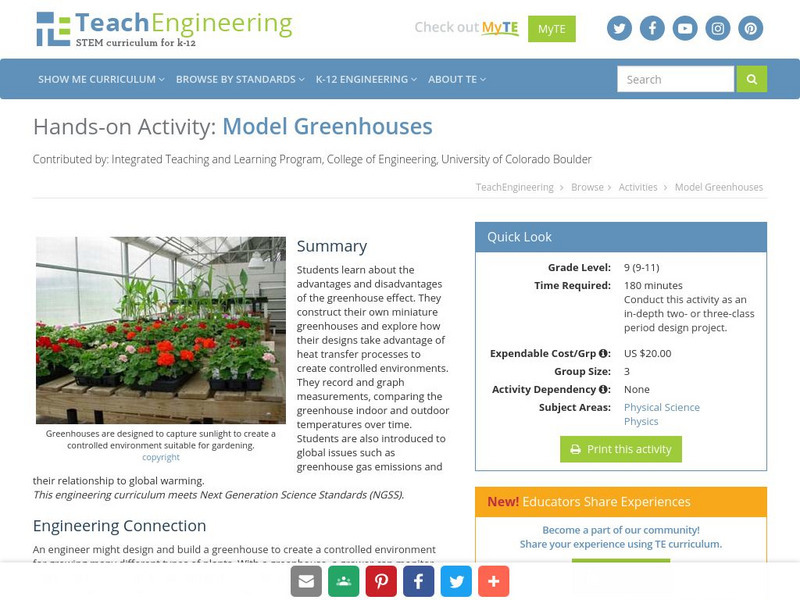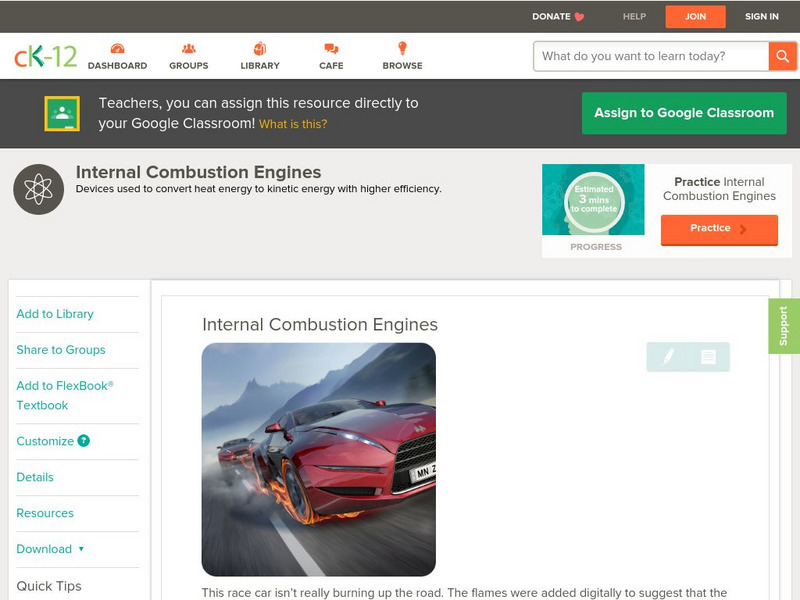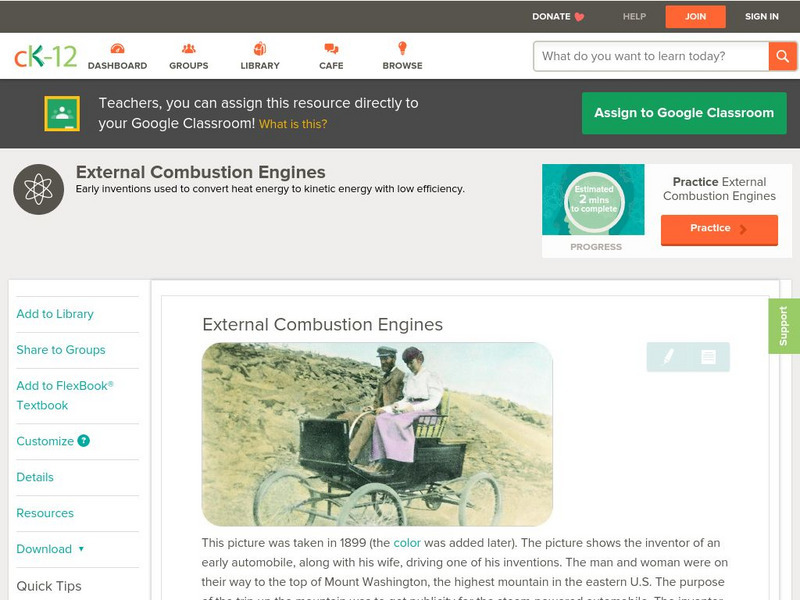Hi, what do you want to do?
Georgia State University
Georgia State University: Hyper Physics: Heat Flow to Hotter Region
Heat flow from a hot region to a cold region is described and explained. Applications of this phenomenon (specifically heat pumps and refrigerators) are discussed. Excellent graphics.
TeachEngineering
Teach Engineering: Hot Potato, Cool Foil
Students explore material properties by applying some basic principles of heat transfer. They use calorimeters to determine the specific heat of three substances: aluminum, copper and another of their choice. Each substance is cooled in...
TeachEngineering
Teach Engineering: What Works Best in a Radiator?
Students learn the importance of heat transfer and heat conductance. Using hot plates, student groups measure the temperature change of a liquid over a set time period and use the gathered data to calculate the heat transfer that occurs....
TeachEngineering
Teach Engineering: Counting Calories
The students discover the basics of heat transfer in this activity by constructing a constant pressure calorimeter to determine the heat of solution of potassium chloride in water. They first predict the amount of heat consumed by the...
Chemistry Collective
Chem Collective: Measuring the Heat Capacity of an Engine Coolant.
As an analytical chemist at a company developing new engine coolants your task is to determine the heat capacity of a newly developed product and then to determine if its heat capacity is greater of less than that of ethylene glycol.
PBS
Pbs Kids: Design Squad Challenge: Feel the Heat (Pdf) [Pdf]
Hands-on challenge to heat things up by building a solar hot water heater. Provides full list of materials with ideas on how to design, build, test, and redesign it if necessary. Activity focuses on the engineering design process and the...
TeachEngineering
Teach Engineering: Passive Solar Design
Students are introduced to passive solar design for buildings--an approach that uses the sun's energy and the surrounding climate to provide natural heating and cooling. They learn about some of the disadvantage of conventional heating...
TeachEngineering
Teach Engineering: Rooftop Gardens
Students explore whether rooftop gardens are a viable option for combating the urban heat island effect. Can rooftop gardens reduce the temperature inside and outside houses? Teams each design and construct two model buildings using foam...
TeachEngineering
Teach Engineering: Solar Power
In this activity, students learn how engineers use solar energy to heat buildings by investigating the thermal storage properties of some common materials: sand, salt, water and shredded paper. Students then evaluate the usefulness of...
Chemistry Collective
Chem Collective: Measuring the Heat Capacity of an Engine Coolant Ii
Measure and compare the heat capacity of an unknown liquid with an unknown density.
TeachEngineering
Teach Engineering: Heat Transfer: From Hot to Not
Students learn the fundamental concepts of heat transfer and heat of reaction. This includes concepts such as physical chemistry, an equation for heat transfer, and a basic understanding of energy and heat transfer.
American Chemical Society
Middle School Chemistry: Chemical Reactions & Engineering Design
This lesson begins with a story about rescuing reptile eggs from a new construction site. Using the story as motivation, learners are presented with an engineering design challenge: Build a portable device which can warm, support, and...
TeachEngineering
Teach Engineering: What Is Heat?
Learners learn about the definition of heat as a form of energy and how it exists in everyday life. They also learn about the three types of heat transfer as well as the connection between heat and insulation.
TeachEngineering
Teach Engineering: Let's Get Breezy!
Students apply an understanding of the concept of heat transfer through convection, conduction, and radiation as they use wireless temperature probes to investigate the heating capacity of different materials under heat lamps.
TeachEngineering
Teach Engineering: Model Greenhouses
Students learn about the advantages and disadvantages of the greenhouse effect. They construct their own miniature greenhouses and explore how their designs take advantage of heat transfer processes to create controlled environments....
TeachEngineering
Teach Engineering: Energy of Motion
By taking a look at the energy of motion all around us, students learn about the types of energy and their characteristics. They first learn about the two simplest forms of mechanical energy: kinetic and potential energy, as illustrated...
Georgia State University
Georgia State University: Hyper Physics: Heat and Thermodynamics
Georgia State University Physics Department privides an incredibly thorough treatment of the laws of thermodynamics. Multiple pages; many informative graphics; opportunities to practice problems and receive immediate feedback.
OpenStax
Open Stax: College Physics: The First Law of Thermodynamics
An online college physics textbook that explores the first law of thermodynamics by defining the processes of a simple heat engine. Section also describes the difference among isobaric, isochoric, isothermal, and adiabatic. Students will...
Exploratorium
Exploratorium: Science Snacks: Dipping Bird
Get a visual representation of a heat engine by looking at the dipping bird. This activity analyzes the steps of the dipping bird to compare it how a heat engine work.
CK-12 Foundation
Ck 12: Physical Science: Internal Combustion Engines
[Free Registration/Login may be required to access all resource tools.] Explains what an internal combustion engine is, how it works, and how kinetic energy from the engine turns the wheels of a car.
CK-12 Foundation
Ck 12: Physical Science: External Combustion Engines
[Free Registration/Login may be required to access all resource tools.] Explains what a combustion engine is, its purpose, and how it works.
Sophia Learning
Sophia: Bill Nye Demonstration: The Stirling Engine
Learn about the Stirling Engine as Bill Nye demonstrates how it works. [3:24]
University of Houston
University of Houston: Engines of Our Ingenuity: On Making Life Livable
Being able to withstand heat and cold is a need shared by rich and poor alike. The author of this speech to the American Society for Heating, Refrigerating, and Air Conditioning Engineers (ASHRAE) provides an anecdotal history of climate...
Science Buddies
Science Buddies: Cold Room? Heat It Up With a Homemade Solar Air Heater
Humans need food, water, and warm shelter to survive. But a lot of humans depend on fossil fuels to supply gas and electricity to heat our homes. But burning fossil fuels to create energy is harmful to the environment. In this science...





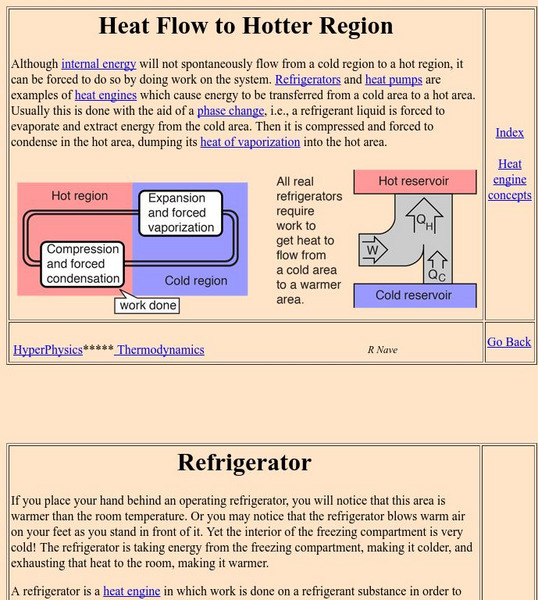
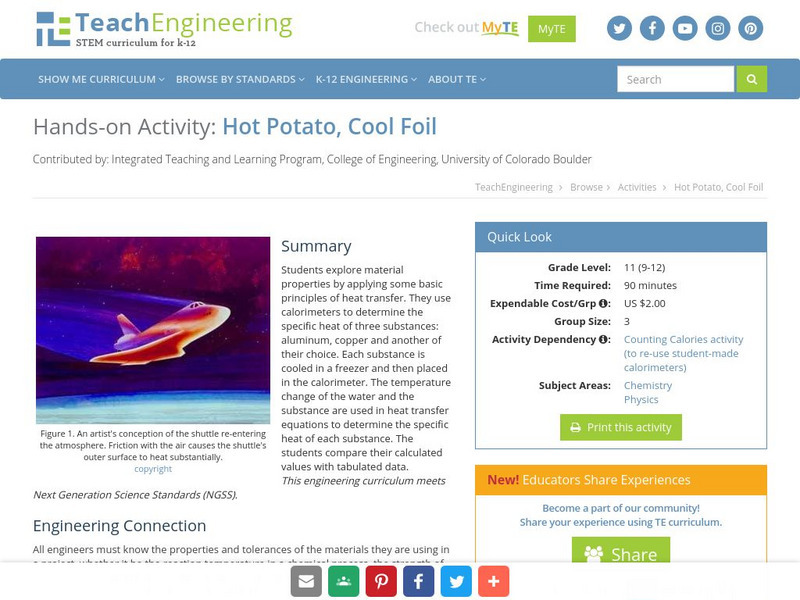
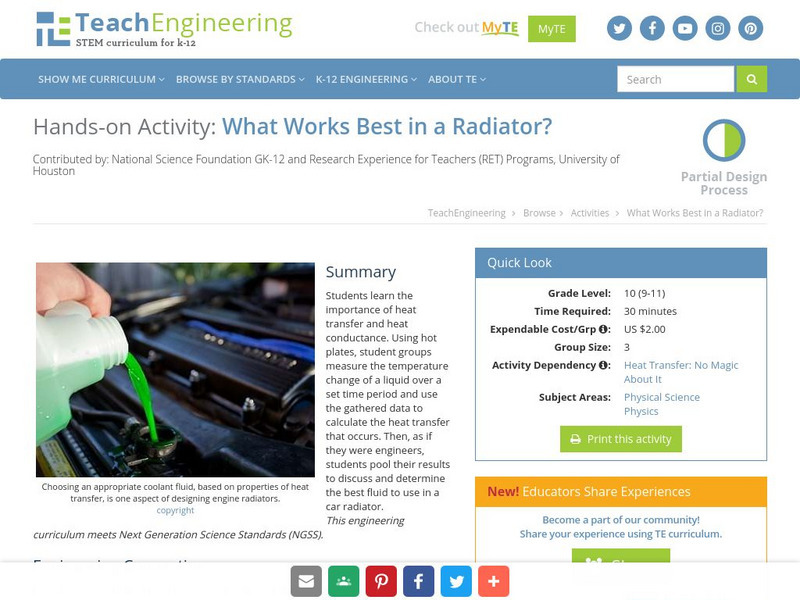
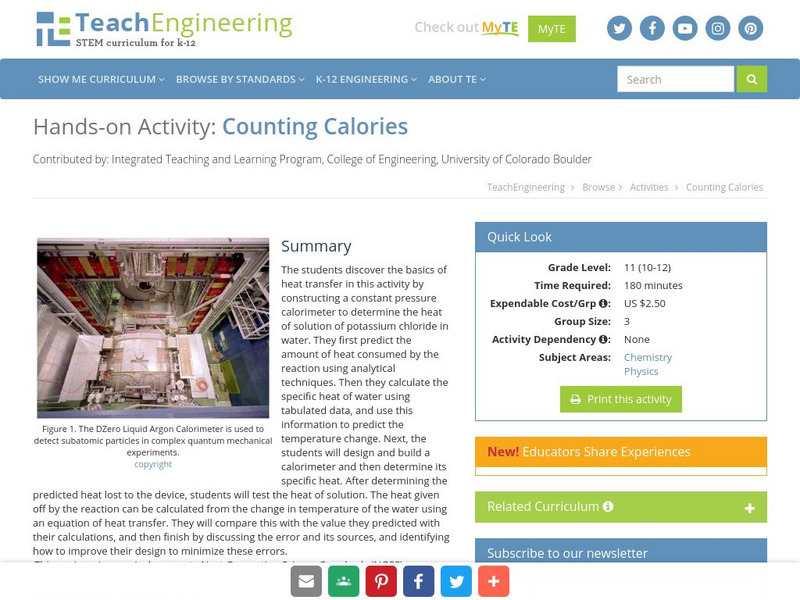

![Pbs Kids: Design Squad Challenge: Feel the Heat (Pdf) [Pdf] Handout Pbs Kids: Design Squad Challenge: Feel the Heat (Pdf) [Pdf] Handout](https://content.lessonplanet.com/knovation/original/39873-ae8d75ec09f51ea05c443973c536d5aa.jpg?1661243849)



